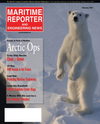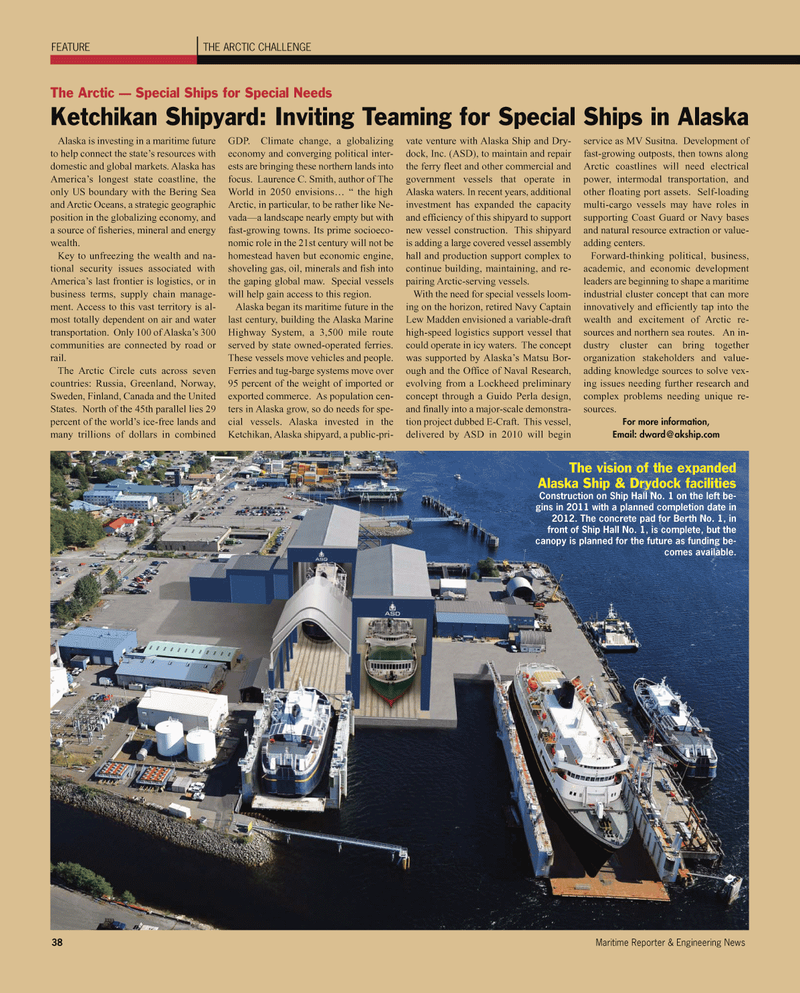
Page 38: of Maritime Reporter Magazine (February 2011)
Cruise & Passenger Vessel Annual
Read this page in Pdf, Flash or Html5 edition of February 2011 Maritime Reporter Magazine
Alaska is investing in a maritime future to help connect the state’s resources with domestic and global markets. Alaska has
America’s longest state coastline, the only US boundary with the Bering Sea and Arctic Oceans, a strategic geographic position in the globalizing economy, and a source of fisheries, mineral and energy wealth.
Key to unfreezing the wealth and na- tional security issues associated with
America’s last frontier is logistics, or in business terms, supply chain manage- ment. Access to this vast territory is al- most totally dependent on air and water transportation. Only 100 of Alaska’s 300 communities are connected by road or rail.
The Arctic Circle cuts across seven countries: Russia, Greenland, Norway,
Sweden, Finland, Canada and the United
States. North of the 45th parallel lies 29 percent of the world’s ice-free lands and many trillions of dollars in combined
GDP. Climate change, a globalizing economy and converging political inter- ests are bringing these northern lands into focus. Laurence C. Smith, author of The
World in 2050 envisions… “ the high
Arctic, in particular, to be rather like Ne- vada—a landscape nearly empty but with fast-growing towns. Its prime socioeco- nomic role in the 21st century will not be homestead haven but economic engine, shoveling gas, oil, minerals and fish into the gaping global maw. Special vessels will help gain access to this region.
Alaska began its maritime future in the last century, building the Alaska Marine
Highway System, a 3,500 mile route served by state owned-operated ferries.
These vessels move vehicles and people.
Ferries and tug-barge systems move over 95 percent of the weight of imported or exported commerce. As population cen- ters in Alaska grow, so do needs for spe- cial vessels. Alaska invested in the
Ketchikan, Alaska shipyard, a public-pri- vate venture with Alaska Ship and Dry- dock, Inc. (ASD), to maintain and repair the ferry fleet and other commercial and government vessels that operate in
Alaska waters. In recent years, additional investment has expanded the capacity and efficiency of this shipyard to support new vessel construction. This shipyard is adding a large covered vessel assembly hall and production support complex to continue building, maintaining, and re- pairing Arctic-serving vessels.
With the need for special vessels loom- ing on the horizon, retired Navy Captain
Lew Madden envisioned a variable-draft high-speed logistics support vessel that could operate in icy waters. The concept was supported by Alaska’s Matsu Bor- ough and the Office of Naval Research, evolving from a Lockheed preliminary concept through a Guido Perla design, and finally into a major-scale demonstra- tion project dubbed E-Craft. This vessel, delivered by ASD in 2010 will begin service as MV Susitna. Development of fast-growing outposts, then towns along
Arctic coastlines will need electrical power, intermodal transportation, and other floating port assets. Self-loading multi-cargo vessels may have roles in supporting Coast Guard or Navy bases and natural resource extraction or value- adding centers.
Forward-thinking political, business, academic, and economic development leaders are beginning to shape a maritime industrial cluster concept that can more innovatively and efficiently tap into the wealth and excitement of Arctic re- sources and northern sea routes. An in- dustry cluster can bring together organization stakeholders and value- adding knowledge sources to solve vex- ing issues needing further research and complex problems needing unique re- sources.
For more information,
Email: [email protected] 38 Maritime Reporter & Engineering News
FEATURE THE ARCTIC CHALLENGE
The vision of the expanded
Alaska Ship & Drydock facilities
Construction on Ship Hall No. 1 on the left be- gins in 2011 with a planned completion date in 2012. The concrete pad for Berth No. 1, in front of Ship Hall No. 1, is complete, but the canopy is planned for the future as funding be- comes available.
The Arctic — Special Ships for Special Needs
Ketchikan Shipyard: Inviting Teaming for Special Ships in Alaska

 37
37

 39
39
